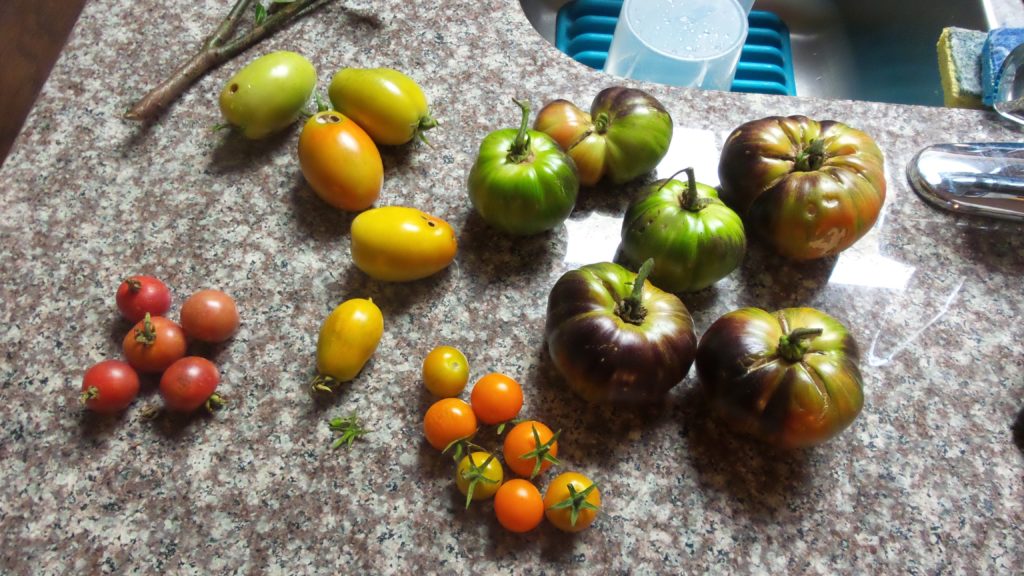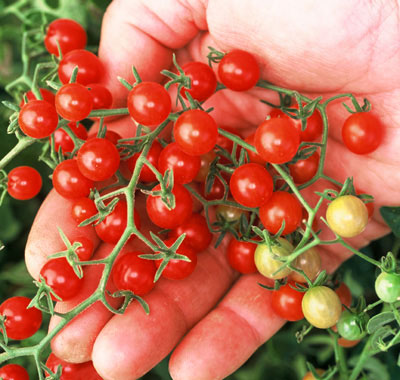 It’s tomato harvest time, and avid gardeners are taking pride collecting and eating their delicious homegrown tomatoes. My personal observation is that gardening pride is directly related to production success, often measured in either weight or volume. While varieties such as Big Beef, Cherokee Purple, Delicious and Mortgage Lifter are beefsteak style tomatoes that may take longer to grow, the payoff are harvests that can equal up to 50 pounds per plant. I encourage readers to take pride in healthy eating habits by an enhancing personal nutrition by consuming tomatoes. According to a reference from Texas A&M AgriLife Extension Path to Plate initiative, tomatoes are fat-free, low in sodium, and a good source of vitamins A and C. Among a variety of vegetables that provide nutrition, tomatoes can provide 15% value of daily recommended vitamin C that is promoted by the U.S. Food and Drug Administration.
It’s tomato harvest time, and avid gardeners are taking pride collecting and eating their delicious homegrown tomatoes. My personal observation is that gardening pride is directly related to production success, often measured in either weight or volume. While varieties such as Big Beef, Cherokee Purple, Delicious and Mortgage Lifter are beefsteak style tomatoes that may take longer to grow, the payoff are harvests that can equal up to 50 pounds per plant. I encourage readers to take pride in healthy eating habits by an enhancing personal nutrition by consuming tomatoes. According to a reference from Texas A&M AgriLife Extension Path to Plate initiative, tomatoes are fat-free, low in sodium, and a good source of vitamins A and C. Among a variety of vegetables that provide nutrition, tomatoes can provide 15% value of daily recommended vitamin C that is promoted by the U.S. Food and Drug Administration.
We should revel in an abundant harvest, then reminisce about our glory days when we produced the largest in weight or higher number of tomatoes. Within a few weeks from now growing tomatoes may feel like a fleeting endeavor. It is true that most of our favorite tomato varieties will stop producing in early summer. This is related to the basic biology of the plant in that higher temperatures, when average nighttime temps are at or above 80 degrees, will affect pollen development and increases the chances of anther drop. Remember that the anther is a structure within a flower that produces pollen.
T omato growing season is also dependent on varietal growth forms called determinate and indeterminate. Determinate, or “bush” tomatoes, are varieties that grow between 3 to 4-feet tall and require limited staking for support. All fruits from determinate varieties ripen at approximately the same time. Indeterminate varieties will grow and produce fruit for a longer period and throughout their season. Cherry tomatoes like Sungold or Sweet Millions are indeterminate varieties that can be harvested well into summer. They can potentially reach a to 8-feet tall and often require substantial staking or caging. Getting to know these two growth forms will help you make a better decision regarding placement in the garden as well as predicting harvest.
omato growing season is also dependent on varietal growth forms called determinate and indeterminate. Determinate, or “bush” tomatoes, are varieties that grow between 3 to 4-feet tall and require limited staking for support. All fruits from determinate varieties ripen at approximately the same time. Indeterminate varieties will grow and produce fruit for a longer period and throughout their season. Cherry tomatoes like Sungold or Sweet Millions are indeterminate varieties that can be harvested well into summer. They can potentially reach a to 8-feet tall and often require substantial staking or caging. Getting to know these two growth forms will help you make a better decision regarding placement in the garden as well as predicting harvest.
There are also heat-tolerant varieties that offer the potential to grow tomatoes into summer. Texas A&M AgriLife Extension Vegetable Specialist Dr. Joe Masabni also suggests extending the growing season by use of these varieties in succession planting by seeding every five to six weeks. Heat tolerant varieties include Mountain Supreme, Heatwave II, Sunmaster, Solar Fire and Solar Set. These are all determinate varieties that mature in approximately 70 days.
I invite you to join us to celebrate tomatoes. We will be hosting an open garden day featuring tomatoes on Saturday, June 8 starting 9 am at the Brazoria Environmental Education Station, our garden center located at 585 CR 443 (also known as Hospital Drive) in Angleton. Tomato Celebration will feature taste testing of varieties grown by Brazoria County Master Gardeners, as well as a presentation by yours truly on tomato culture. To find out more information about our programs, visit us online: https://brazoria.agrilife.org. I also encourage you to share your recommended tomato varieties by browsing online to my Facebook page: www.facebook.com/horticulturiststephenb. Cheers to you, and I’ll see you in the garden.
